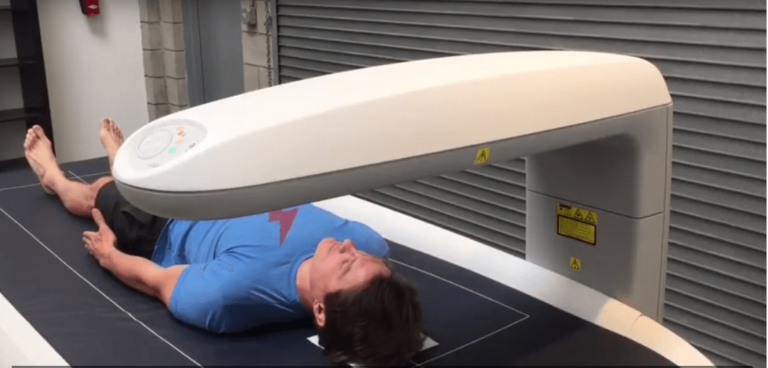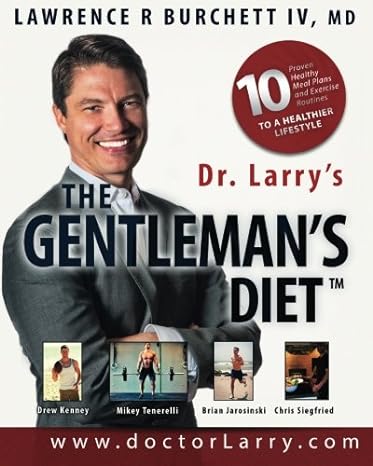What is a Dexa Scan and How Do You Read Its Results?

Dr. Larry Burchett has two goals: to lose fat and put on muscle. In this video, he takes his first step — measuring his current percentage of body fat and lean body mass with a Dual-Energy X-ray Absorptiometry (DEXA) scan.
Dr. Larry Burchett: I’m here at Body Spec With Leann, who’s going to give me my results of my Dexa scan and tell me my body fat percentage. I’m a little nervous, but I’m interested to see where I’m at.
Leann: Well this is your first scan, and this is you. Green is lean tissue; red is fat tissue. This is the weight of your skeleton in pounds. That’s how much lean mass you have.
Dr. L: So wait a minute — my skeleton weighs six pounds?
L: 6.6 to be exact.
Dr. L: That’s it? My skeleton is only six pounds?
L: Really, that’s actually not bad.
Dr. L: You mean that’s like a good number? I thought my bones would be heavier than six pounds.
L: Well what I can tell you is that’s about right. Sometimes we’ll see eight pounds. The highest I’ve seen is 13.
Dr. L: Wow, 13. So there is something about being big-boned. Some people are big boned.
L: There is absolutely much truth to that.
Dr. L: Okay, so today I was 172 pounds — with clothes on and keys in my pocket. Let’s make sure we account for those. So that’s 133.7 of muscle and 32 pounds of fat, so that is 18.5 percent body fat. That’s not terrible.
L: And not to interrupt you, Lawrence, but you said muscle here, and I haven’t said muscle yet. This is lean tissue. The Dexa scan knows the density of bone and it knows the density of fat, and absolutely everything else is lumped into lean tissue. So for example, your heart, I’d like to think is not made of bone, and hopefully it’s not made of fat.
Dr. L: It can be pretty cold and hard at times, but no, it’s muscle.
L: So your heart is going to be [included in lean tissue], organs, blood, water…
Dr. L: Okay, so 133 of muscle is a bit much.
L: It’s a bit much. We’ll call it lean tissue, but yes, muscle is in there. And if you had lunch, it would be in there also. Unless you ate fat for lunch, then it would be in fat. So based on your age, for our purposes, you’r e sort of flirting with what we test elite athletes. So anything below 18 percent on a Dexa scan is what we look for, and we do all the professional teams here in L.A.
e sort of flirting with what we test elite athletes. So anything below 18 percent on a Dexa scan is what we look for, and we do all the professional teams here in L.A.
Dr. L: For the lowest of elite athletes that you see, what number is that?
L: Last week, I saw my first 7.5 percent body fat.
Dr. L: So I feel like I’ve heard 3 percent or 5 percent, but not on Dexa, right? 7.5 is going to be super lean – like ridiculous, elite athlete lean.
L: On this photo of you, ironically, as you become leaner, this will disappear, and you’re just going to have little slivers.
Dr. L: My hips. She’s pointing to my hips, by the way. I’ll show you this picture in a minute. So okay, 7.5. But that sounds extreme to me.
L: Yes, and they have coaches, they’re doing two or three workouts a day. They have health coaches, they have strength and conditioning coaches.
Dr. L: Do you think 7.5 is like, bodybuilder show lean? Or is that more like a 10? I’m trying to get a gauge of these numbers.
L: The “show lean” for the guys, they definitely want to get somewhere around eight on a Dexa.
Dr. L: Eight on a Dexa. And that’s like, you’re miserable for a month eating carrots?
L: Some of them are happy! For women, it’s usually 10 or less. But again, you’re flirting with the elite athletes. You’re 0.5 percent off.
Dr. L: This is perfect, because I’m at the beginning of what I’m calling the Dr. Burchett Smack Talk Challenge, where I’m going to do this with people. We’re going to talk a little trash. So when you say flirting with elite athletes, I love the idea that if I lose some fat and I gain some more muscle, I’m going to be in the category of what you would call an elite athlete. I like that a lot. That’s very motivating.
L: And at the end of the day, we don’t want you to lose your lean tissue. If anything, we’d love for you to keep it or get more of it. This is what we want to see.
Dr. L: So what I want to do is both, and that’s like the Holy Grail, right? How do you put on some more lean tissue and decrease fat at the same time?
L: That is the Holy Grail, which we’ll get to shortly. Honestly, at the end of the day, if you just do cardio only, a lot of times we’ll see this [lean tissue] go down.. Or if someone does some crazy, low-carb diet, it goes down, because every time you store a gram of carbohydrates, you’re storing a gram of water.
Dr. L: So if you just do cardio, you might lose a little lean tissue. Also if you do some crazy fad dieting, you’re probably going to lose lean tissue too, which, in the long run, can put you at a disadvantage if you’re trying to keep your weight off.
L: Right. And you’ll see greater changes if you do both, like you suggested, which is gaining lean tissue and dropping the fat. You’ll see this change immensely.
Dr. L: So in two months, what’s a reasonable goal, would you say? I’m not going to go insane, but I’m going to hit it hard.
L: You know, that all really depends on you. We get that question a lot. Like, “Okay, in two months, how much percent could I lose?” And I’d say you could lose a couple, but that depends on the intensity of your workouts, the type of calories or the quality of the calories you’re eating… There’s much that goes into what’s going to change that percentage. And I’m just going to be honest, with the Dexa, if you come back in two hours and you just drank a gallon of water, you’re going to be leaner, because that gallon of water is going to increase this [lean tissue]. So I’m just trying to give you some context.
Dr. L: How much would that increase it? A pound?
L: Maybe a couple pounds. However, make sure you come in, your next scan, in the afternoon so you can keep everything consistent.
Dr. L: So it’s similar, right. Okay. That makes sense.
L: These are the five regions that we like to track over time, just to give you a sense of what’s what. The trunk — and you’ll show them on this photo — is the upside down house. It’s the rectangle and the triangle.
Dr. L: So that’s chest, abdomen and pelvis.
L: Front and back, yes. Within your trunk, the bottom of your rib and the top of your hip, is what we call the android region. The gynoid region is the upper hips, bottom and thigh. It starts right here at the pubic bone. Within each region, we know your total mass, and within that mass, we also know how much fat tissue, lean tissue and bone you have, in pounds.
Dr. L: Okay, so we’re back here with LeAnn, and she’s breaking down my Dexa scan results and body fat percentage by region right now. We had a little technical difficulty where the camera fell over in the chair. Okay, so where were we?
L: In this regional assessment, there are five regions we like to track. The trunk on this photo, which you’ll show them, is the upside down house.
Dr. L: Right, so we got all of that, and broke down all of the arms, legs, trunk, android and gynoid.
L: And, since we know the total mass of each particular region, and we know how much fat is in the region, we can determine the percentage of fat in the region. So in the android — the lower abdominal region, which is the bottom of your ribs and the top of your hips —
Dr. L: So my gut.
L: Yep.
Dr. L: So I see anywhere from 16 percent [body fat] in the arms, and then 21 percent in the gut. So I’ve got a little bit of a gut.
L: So at the end of the day, with all of these regions, this is the one we look at the most – the “gut.” This is what we look at because there are more documented studies based on this region than there are, say, based on your arms.
Dr. L: Well that’s where you’re going to store more fat than your arms. That makes sense. That’s where the trunk is.
L: As you become leaner, this will start whittling away, and again, you’ll still have some here.
Dr. L: So we’ve got this picture, and as you can see, green is lean mass, and the orange is the fat. So she’s kind of showing me how I’m going to lose some of that orange.
L: This is an estimate of your resting metabolic rate (RMR), how many calories you need at rest. And it’s just an estimate.
Dr. L: So this is calories per day at rest.
L: 24 hours in bed.
Dr. L: So 1,667 is what I need on a day when I’m not exercising.
L: It’s an estimate based on your height, your weight, your age and your gender. We actually have a separate test for that here. You’re leaner than the average male, so I’m thinking you’re going to be much higher than that with your RMR.
Dr. L: Interesting. This is great. This is way more information than I thought I was going to get.
L: Maybe more than you want them to know!
Dr. L: For $45, this is a bargain!
L: The percentage of fat in your android region — the goal is to have that percentage, over time, be less than your overall body fat percentage.
Dr. L: Okay, so the android region is 21 percent for me, and total body fat is 18 percent. So we want this 21 to be less than 18.
L: Yes, and as [your body fat percentage] goes down, you want your android to chase it.
Dr. L: So both go down at the same time.
L: Yes. And the percentage of fat in your android region — the goal is to have that be less than what is in your hips, bottom and thigh. At the end of the day, whatever weight you have, if you have it below the belt, there are less health risks associated than having it above the belt.
Dr. L: Yeah, intra-abdominal obesity.
L: This is a more specific sketch of the android region. There are two regions. One is your visceral region, so that’s the internal fat around your organs. And the second region is your subcutaneous, which is just under the skin. That number right there, 0.73, is what you have in the visceral region of your android area. The goal is to get that visceral to zero over time.
Dr. L: So wait a minute, this is 0.73 pounds?
L: 0.73 pounds.
Dr. L: So it’s not even a pound.
L: Not even a pound.
Dr. L: So I want to get this less than one pound to zero — no visceral fat, or organ fat.
L: And for men, anything greater than 2.7 pounds of visceral fat is considered a risk factor. Things that make that go up include stress, sugars, and eating late at night.
Dr. L: Stress, and sometimes I eat late at night. Okay.
L: Since we know your total fat is 2.4 pounds, if we subtract the 0.73 from 2.4, that’s what you have just under the skin. So a little over a pound, a pound and a half I think.
Dr. L: And you’re going to have some fat there. You can’t make that zero.
L: You’re absolutely correct about that. In fact, we’ve tested some lean men who were at 9.5 percent, and they had a pound of visceral fat, which I found amusing.
Dr. L: They had a pound of visceral fat, even though they were super lean?
L: Correct.
Dr. L: Wow, that’s interesting. So people put it in different places.
L: And honestly, it’s harder for men to get that visceral fat down to zero. It’s much easier for women. I’m sure it has everything to do with the hormones.
Dr. L: Most things do!
L: You had a Dexa scan, so you’re compared to other men your age and ethnicity. Based on the Dexa, your bones are 75 percent more dense than other men your age and ethnicity. So that’s good. Things that make that increase are a calcium supplement or calcium in your diet and weight training. Things that make that go down – caffeine, nicotine, and soft drinks.
Dr. L: Vitamin D and weights. Okay. It’s interesting. Now I’m wondering, am I going to try a Vitamin D supplement, just for fun?
L: Well if you’re getting it already in your diet, I wouldn’t make any changes. But that’s your call, obviously. Down here, we’re just looking to see if you’re an injury waiting to happen. For the most part, it looks like your arms and your legs are relatively even. You have 0.3 pounds more in your right arm [than left], and it looks like your left leg has 0.4 more pounds [than your right leg].
Dr. L: Oh, that’s interesting. So my right arm has more muscle, and I know this one is stronger. And then my left leg has more.
L: And again, this could be all things. You probably spend a good amount of time standing, so that might be the leg you lean on. Maybe you play a sport, or maybe you have a muscle car and your clutch is really heavy. It’s hard to say.
Dr. L: I have a 2001 Civic, so we’ll go with yes on the muscle car thing.
L: You have nothing greater than two pounds [of difference], so you’re good to go. Your final four pages are just data plots, which today will mean nothing because it’s just your data from your regional assessment. We plot it so we can track over time where you’re gaining.
Dr. L: Okay, so this is day one, the starting line. So let’s get back to my question that you dodged. I’m thinking about doing this in one month or two months. What do you recommend for a re-check?
L: If you’re motivated by numbers, I would come between six to eight weeks.
Dr. L: So six weeks at the earliest.
L: No, you could come in four weeks. It depends. If you say, starting tomorrow, I’m going to do blank, I’m going to make these changes —
Dr. L: Starting today. Starting now.
L: Starting now — and this is how much of this and this and this I’m going to have, we need to see if it’s working. So I would come back in four weeks.
Dr. L: So a month is enough time.
L: Yeah. Two or three weeks is a little early. Will you see changes? Sure, but they will be minor.
Dr. L: Okay, so a month. What’s the craziest anybody’s done in a month?
L: The craziest I’ve seen has been with intermittent fasting, but that’s totally different.
Dr. L: Okay, how about for somebody like me who is trying to cut down a little bit.
L: Could be four to six pounds of fat.
Dr. L: Is that like, one percent?
L: It all depends on how much you weigh when you come in, and that weight is based on the amount of lean tissue.
Dr. L: How about putting on muscle? And I’m not using steroids.
L: It takes about six months to really put on true muscle. So if you know how muscle building takes place, a lot of the weight that you may be gaining is actually you storing more carbohydrate in that muscle so you have more energy for your next workout. But the actual muscle fibers themselves take a certain period of time to truly develop, between four to six months. But yes, absolutely you can get more lean tissue, but just caveat that.
Dr. L: I’m trying to come up with a goal. Do I want [my body fat percentage] down 1 percent in a month? 2 percent is a bit much?
L: You could go with 2 percent. We need to see, are you healthy? Is your immune system like shocked because you did it so quickly and so fast?
Dr. L: No, I want to do this where basically I get a little more serious about working out. We’re not talking about 3 hours a day, like an hour a day five days a week.
L: That’s healthy.
Dr. L: And then, no I just want to take out a little bit of carbs, add some more vegetables and keep my protein.
L: And lots of water. So, 2 percent is not a bad goal.
Dr. L: In two months or one month?
L: How about between 1 and 2 months. Also you know that one pound of fat is 3500 calories. So at the end of the day, I’m not a big proponent of one losing more than a pound in a week, because that’s very significant.
Dr. L: Agreed. And I don’t have a ton to lose, so I’m more like half a pound. So I think my goal is going to be 2 months, I want to put on five pounds of lean tissue, and I’m not sure how much fat I’m going to lose.
L: You could lose anywhere between 2-6 pounds… I mean again, we don’t know.
Dr. L: It’s hard for me to gauge that. But I think I want to be like 175, and have 5 more pounds of muscle, so that would mean lose a couple pounds of fat. And I can do that. Half a pound a week? I can do that. I think that’s the goal. Let’s do those numbers real quick. So what would that be percent body fat?
*Math*
L: If you had 30 pounds of fat, your body fat percentage would drop down to 17.1.
Dr. L: 17.1. So that would be like 1.5 percent in two months. So maybe that will be my goal – get down to 17.
L: That’s a healthy goal.
Dr. L: Yeah. We want to do this healthy. Not just crash dieting… something a little more sustainable. Well this was really helpful.
L: You’re absolutely welcome.
***
I will be back in six weeks to check in. I’m excited and motivated about this. So my questions to you are:
- Where are you now? What’s your level of fitness? What’s your weight?
- What is your goal? What do you want?
- What’s your plan? How are you going to get from A to B? What are you going to eat, and what exercises are you going to do?
In this process, if you take the Dr. Burchett Smack Talk Challenge, I’m going to walk you through figuring out what’s important to you, translating that into goals, and connecting that to what’s authentically driving you. Then, we’re going to cover all of the behavior modification to help you get there. I’ve got dieticians, nutritionists, personal trainers, and great people who have had success with this. So tune in and join this weight loss challenge. It’s going to be a lot of good information, and I look forward to taking you down — to talking a little trash and having fun doing it a different way.


